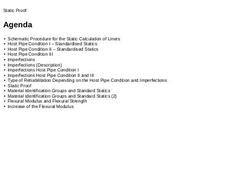
|
|
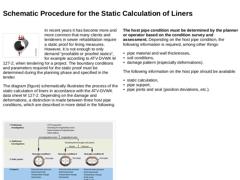
|
(Image: Statik) In recent years it has become more and more common that many clients and tenderers in sewer rehabilitation require a static proof for lining measures. However, it is not enough to only demand “proofable or proofed statics", for example according to ATV-DVWK M 127-2, when tendering for a project. The boundary conditions and parameters required for the static proof must be determined during the planning phase and specified in the tender. |
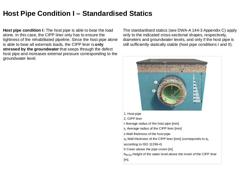
|
Host pipe condition I: The host pipe is able to bear the load alone. In this case, the CIPP liner only has to ensure the tightness of the rehabilitated pipeline. Since the host pipe alone is able to bear all externals loads, the CIPP liner is only stressed by the groundwater that seeps through the defect host pipe and increases external pressure corresponding to the groundwater level. The standardised statics (see DWA-A 144-3 Appendix C) apply only … |
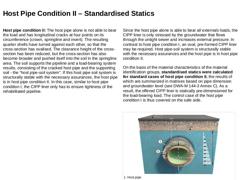
|
Host pipe condition II: The host pipe alone is not able to bear the load and has longitudinal cracks at four points on its circumference (crown, springline and invert). The resulting quarter shells have turned against each other, so that the cross-section has ovalised. The clearance height of the cross-section has been reduced, but the cross-section has also become broader and pushed itself into the soil in the springline area. The soil supports … |
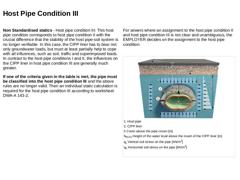
|
Non Standardised statics - Host pipe condition III: This host pipe condition corresponds to host pipe condition II with the crucial difference that the stability of the host pipe-soil system is no longer verifiable. In this case, the CIPP liner has to bear not only groundwater loads, but must at least partially help to cope with all influences, such as soil, traffic and superimposed loads. In contrast to the host pipe conditions I and II, the influences … |
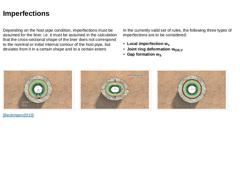
|
Depending on the host pipe condition, imperfections must be assumed for the liner, i.e. it must be assumed in the calculation that the cross-sectional shape of the liner does not correspond to the nominal or initial internal contour of the host pipe, but deviates from it in a certain shape and to a certain extent. In the currently valid set of rules, the following three types of imperfections are to be considered: -
Local imperfection wv
-
Joint ring …
|
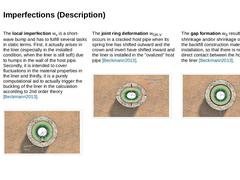
|
The local imperfection wv is a short-wave bump and has to fulfill several tasks in static terms. First, it actually arises in the liner (especially in the installed condition, when the liner is still soft) due to humps in the wall of the host pipe. Secondly, it is intended to cover fluctuations in the material properties in the liner and thirdly, it is a purely computational aid to actually trigger the buckling of the liner in the calculation according … |
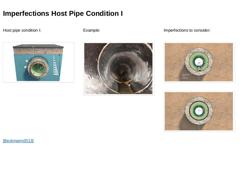
|
Host pipe condition I: (Image: Host pipe condition I) Example: (Image: Pipe in host pipe condition I ) Imperfections to consider: (Image: Local imperfection)
(Image: Gap formation) [Beckmann2013] |
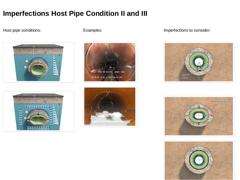
|
Host pipe conditions: (Image: Host pipe condition II)
(Image: Host pipe condition III) Examples: (Image: Pipe in host pipe condition II)
(Image: Pipe in host pipe condition III) Imperfections to consider: (Image: Local imperfection)
(Image: Joint ring deformation (Fourfold longitudinally cracked))
(Image: Gap formation) [Beckmann2013] |
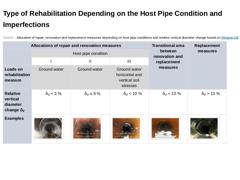
|
(Table: Allocation of repair, renovation and replacement measures depending on host pipe conditions and relative vertical diameter change based on [Wagner18]) |
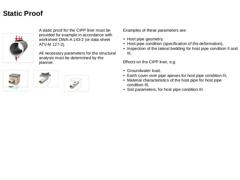
|
(Image: Picto Statik) A static proof for the CIPP liner must be provided for example in accordance with worksheet DWA-A 143-2 (or data sheet ATV-M 127-2). All necessary parameters for the structural analysis must be determined by the planner. (Image: Rehabilitated pipeline load - Groundwater load) (Image: Rehabilitated pipeline load - Soil load) (Image: Rehabilitated pipeline load - Traffic load) (Image: Rehabilitated pipeline load - Dead weight of … |
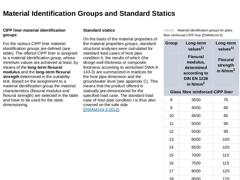
|
CIPP liner material identification groups For the various CIPP liner material identification groups are defined (see table). The offered CIPP liner is assigned to a material identification group, whose minimum values are achieved at least, by means of the long-term flexural modulus and the long-term flexural strength determined in the suitability test. Based on the assignment to a material identification group the material characteristics (flexural … |
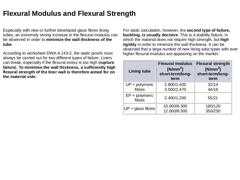
|
Especially with new or further developed glass fibres lining tubes, an extremely strong increase in the flexural modulus can be observed in order to minimize the wall thickness of the tube. According to worksheet DWA-A 143-2, the static proofs must always be carried out for two different types of failure. Liners can break, especially if the flexural stress is too high (rupture failure). To minimise the wall thickness, a sufficiently high flexural … |
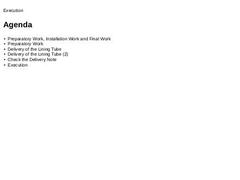
|
|
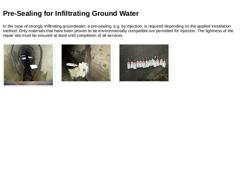
|
In the case of strongly infiltrating groundwater, a pre-sealing, e.g. by injection, is required depending on the applied installation method. Only materials that have been proven to be environmentally compatible are permitted for injection. The tightness of the repair site must be ensured at least until completion of all services. (Image: Infiltration (BBF) of groundwater into a sewer bed – gushing – entering under pressure (code suffix D)) (Image: … |
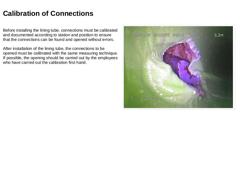
|
Before installing the lining tube, connections must be calibrated and documented according to station and position to ensure that the connections can be found and opened without errors. After installation of the lining tube, the connections to be opened must be calibrated with the same measuring technique. If possible, the opening should be carried out by the employees who have carried out the calibration first hand. (Image: Milling error when opening … |
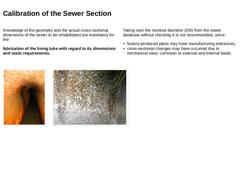
|
Knowledge of the geometry and the actual cross-sectional dimensions of the sewer to be rehabilitated are mandatory for the fabrication of the lining tube with regard to its dimensions and static requirements. Taking over the nominal diameter (DN) from the sewer database without checking it is not recommended, since: -
factory-produced pipes may have manufacturing tolerances,
-
cross-sectional changes may have occurred due to mechanical wear, corrosion …
|
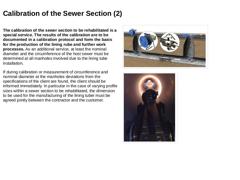
|
The calibration of the sewer section to be rehabilitated is a special service. The results of the calibration are to be documented in a calibration protocol and form the basis for the production of the lining rube and further work processes. As an additional service, at least the nominal diameter and the circumference of the host sewer must be determined at all manholes involved due to the lining tube installation. If during calibration or measurement … |
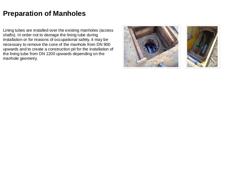
|
Lining tubes are installed over the existing manholes (access shafts). In order not to damage the lining tube during installation or for reasons of occupational safety, it may be necessary to remove the cone of the manhole from DN 900 upwards and to create a construction pit for the installation of the lining tube from DN 1200 upwards depending on the manhole geometry. (Image: Construction pit for a rehabilitation using a lining tube DN 1000 - The … |
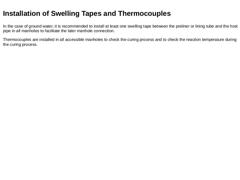
|
In the case of ground water, it is recommended to install at least one swelling tape between the preliner or lining tube and the host pipe in all manholes to facilitate the later manhole connection. Thermocouples are installed in all accessible manholes to check the curing process and to check the reaction temperature during the curing process. |
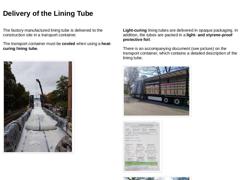
|
The factory manufactured lining tube is delivered to the construction site in a transport container. The transport container must be cooled when using a heat-curing lining tube. (Image: Transport container with cooled lining tube) Light-curing lining tubes are delivered in opaque packaging. In addition, the tubes are packed in a light- and styrene-proof protective foil. There is an accompanying document (see picture) on the transport container, which … |
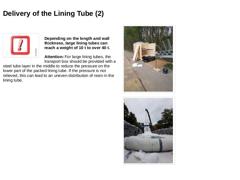
|
Important: Depending on the length and wall thickness, large lining tubes can reach a weight of 10 t to over 40 t. Attention: For large lining tubes, the transport box should be provided with a steel tube layer in the middle to reduce the pressure on the lower part of the packed lining tube. If the pressure is not relieved, this can lead to an uneven distribution of resin in the lining tube. (Image: Transport box with steel tube layer to reduce the … |
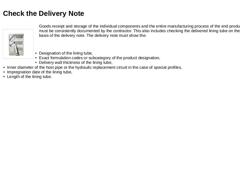
|
(Image: Picto Liste) Goods receipt and storage of the individual components and the entire manufacturing process of the end product must be consistently documented by the contractor. This also includes checking the delivered lining tube on the basis of the delivery note. The delivery note must show the: -
Designation of the lining tube,
-
Exact formulation codes or subcategory of the product designation,
-
Delivery wall thickness of the lining tube,
-
…
|
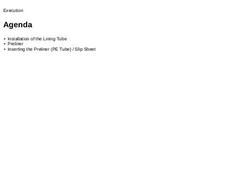
|
|
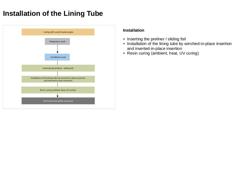
|
(Image: Schematic procedure for the execution of lining with cured-in-place pipes - Installation work) -
Inserting the preliner / sliding foil
-
Installation of the lining tube by winched-in-place insertion and inverted-in-place insertion
-
Resin curing (ambient, heat, UV curing)
|